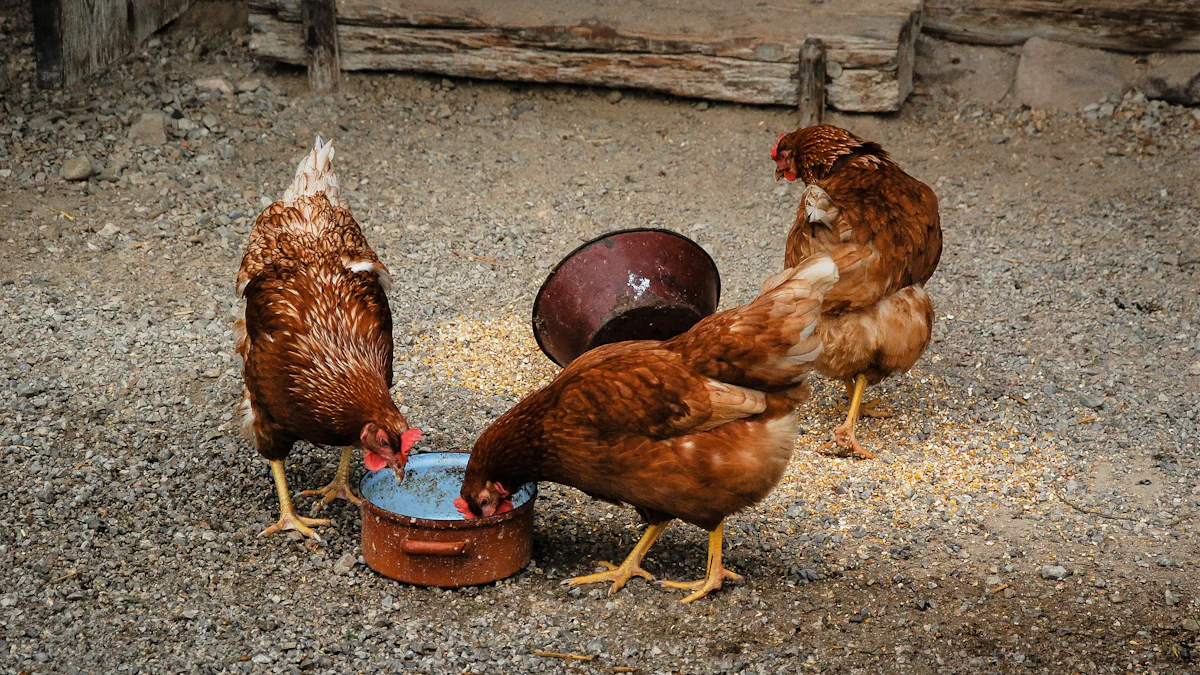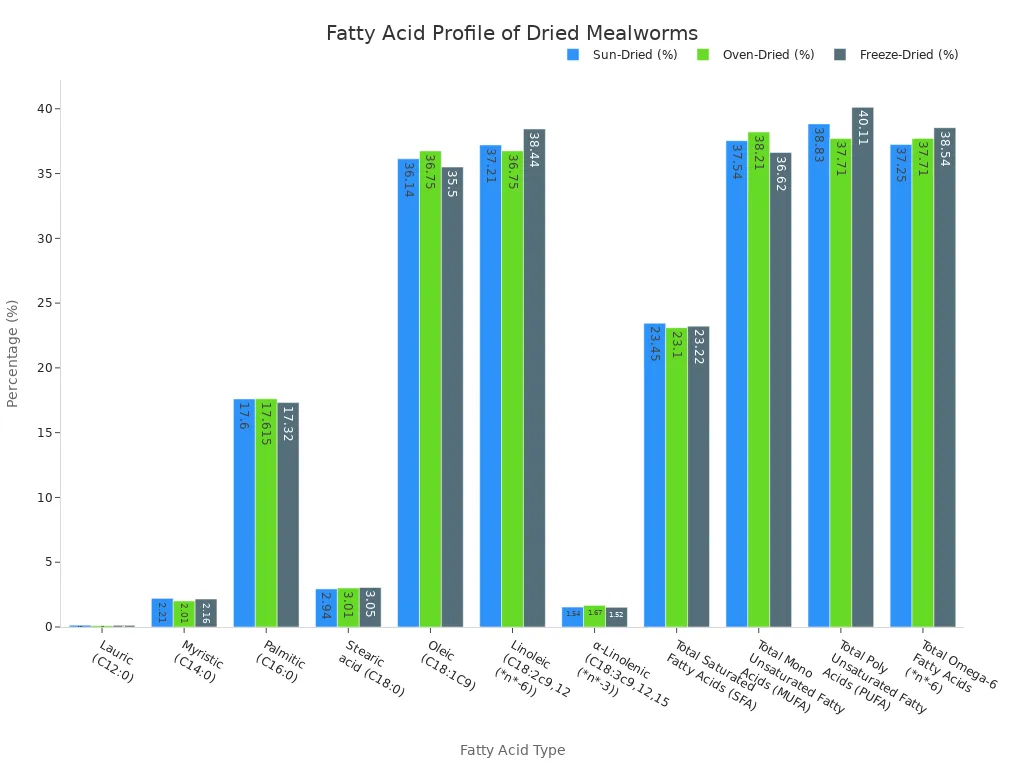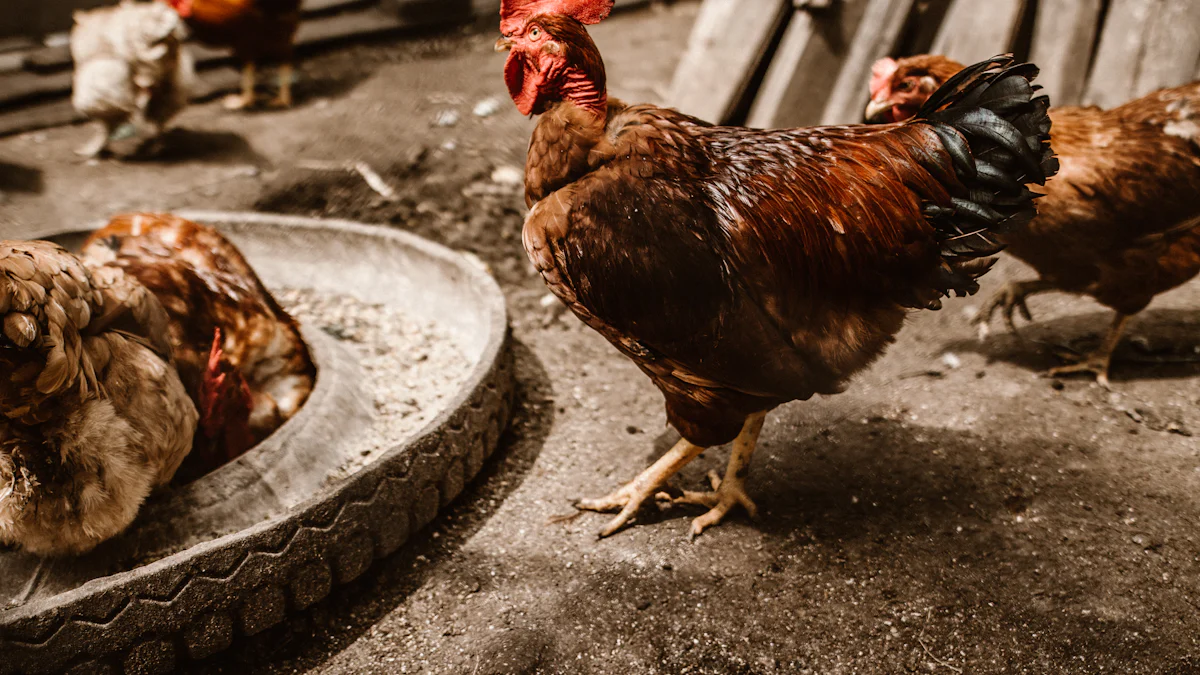
Introduction
Dried mealworms offer an excellent protein boost for chickens. They are not a complete meal, but they deliver significant nutritional advantages. These advantages support overall flock health and boost productivity. Understanding their proper use is crucial. This helps maximize the benefits of chicken feed mealworms for your feathered friends.
Key Takeaways
- Dried mealworms give chickens a lot of protein. This helps them grow and lay eggs.
- Mealworms have important nutrients. These include minerals and healthy fats for chicken health.
- Give mealworms as a treat, not a main meal. This helps chickens stay healthy and happy.
The Nutritional Power of Dried Mealworms for Chickens

High Protein Content for Growth and Production
Dried mealworms are a protein powerhouse for chickens. They offer a significant boost for growth and egg laying. These tiny treats pack a punch, with crude protein content often ranging from 45% to over 70%. For example, some studies show mealworm meal with 47% to 54.4% crude protein. This makes them a competitive protein source.
| Feed Ingredient | Crude Protein Content (% DM) |
|---|---|
| Dried Mealworms | 49.1 – 50.8 |
| Soybean Meal | 49 – 56 |
| Fish Meal | 65.5 – 73 |
Mealworms contain many essential amino acids. These are the building blocks for strong muscles and healthy feathers. They make up about 50% of the total amino acid content. Arginine and leucine are especially abundant. Arginine can be as high as 78 mg/g, and leucine reaches 62 mg/g. This balanced amino acid profile helps chickens grow well. Studies show that adding mealworms to a chicken’s diet can increase body weight and daily weight gain. It also positively affects carcass percentage and breast weight. This means healthier, more robust birds.
Essential Nutrients for Overall Health
Beyond protein, dried mealworms deliver a treasure trove of essential nutrients. They contain important minerals. These include potassium, magnesium, phosphorus, iron, copper, zinc, manganese, and selenium. Mealworms offer much higher levels of these compared to traditional animal products. For instance, their calcium content is over three times higher than eggs. It is about 23 times more than pork and beef. They also provide significantly more iron, copper, and zinc.
However, mealworms are naturally low in calcium. They have a low calcium:phosphorus ratio. This means you should not feed them exclusively. Always ensure a balanced diet.
| Mineral | Quantity (%) |
|---|---|
| Calcium (Ca) | 0.70 |
| Total Phosphorus (P) | 0.60 |
Mealworms also boast a beneficial fatty acid profile. They contain both omega-3 and omega-6 fatty acids. Linoleic acid (an omega-6) and oleic acid are particularly plentiful. These healthy fats contribute to overall chicken health and energy. The high amount of unsaturated fatty acids helps maintain good fat digestion. Mealworms also contain chitin. Chitin acts like a prebiotic. It can improve gut health. It helps decrease bad bacteria like E. coli and Salmonella. It also increases good bacteria like Lactobacillus. This leads to a healthier digestive system for your flock.

Supporting Natural Foraging Behavior
Chickens love to scratch and peck. It is their natural instinct. Dried mealworms are perfect for encouraging this behavior. When you scatter chicken feed mealworms on the ground, your flock immediately starts foraging. They scratch through the dirt and peck at the tasty treats. This activity mimics their natural environment. It provides excellent physical exercise. It also offers mental stimulation.
Scattering mealworms in a chicken’s area encourages natural foraging behaviors like scratching and pecking. This activity mimics their natural environment, promoting physical activity, mental stimulation, and overall well-being while reducing stress.
This natural engagement keeps chickens active and happy. It helps reduce boredom and stress within the flock. Happier chickens are more vigorous. They have a better quality of life. This simple act of scattering mealworms brings out their natural instincts. It makes them feel more at home.
Incorporating Dried Mealworms into Your Chicken Feed Mealworms Diet

Recommended Feeding Guidelines and Moderation
Giving your flock dried mealworms is a fantastic idea, but remember that moderation is key! Think of them as a special treat, not the main course. A good rule of thumb is to offer about 10–12 mealworms per hen every other day. This keeps them excited without overdoing it. Mealworms should make up no more than 10% of a chicken’s total diet. This ensures your birds still get all the balanced nutrients from their regular feed.
It is important to keep their diet balanced. Too much of a good thing can sometimes cause problems. For example, if a chicken has kidney issues, she needs a diet with limited protein, usually between 16% and 18%. In such cases, you should reduce or even avoid feeding mealworms. Always aim for a happy, healthy balance in their meals.
Creative Ways to Serve Mealworms
Chickens love a good game, and mealworms make the perfect prize! You can simply scatter chicken feed mealworms on the ground in their coop or run. This encourages them to scratch and peck, just like they would in nature. It is a fun way to keep them busy. While scattering them provides immediate excitement, the foraging fun might be short-lived. To keep the party going, try offering these tasty treats more often throughout the day, perhaps at different times. This keeps your flock engaged and active for longer periods.
Here are some other fun ways to serve them:
- Mix them in: Stir dried mealworms into their regular feed. This boosts the protein content of their daily meal.
- Rehydrate for little ones: Young chicks might find dried mealworms a bit tough. Soak them in water for about 30 minutes. This makes them soft and much easier for tiny beaks to eat. Rehydrating also helps prevent dehydration in young birds. You can even soak them in hot water for 15 minutes or add a few drops of vegetable oil. Adult birds usually enjoy them dry, but a softened treat can be a nice change!
- Treat balls: Put mealworms inside a treat ball or a hanging feeder. This makes them work a little for their snack, adding extra enrichment.
When to Offer This Protein-Rich Treat
Knowing when to offer dried mealworms can maximize their benefits for your flock. These protein-packed snacks are especially helpful during certain times in a chicken’s life.
-
Molting Season: When chickens molt, they lose their old feathers and grow new ones. This process demands a lot of protein! Feathers are about 85% protein. Offering mealworms during this time provides the extra protein they need for strong, healthy feather regrowth. This can improve feather quality and make them fluffier. Make sure their diet has high-quality amino acids like lysine and methionine. Reduce low-protein treats like scratch grains during molting.
Nutrient/Component Mealworms Regular Chicken Feed Feathers Protein Content 30% 16-18% 85% -
Egg Production: Laying hens need plenty of protein to produce eggs. It takes a lot of protein to create each egg! Giving your laying hens extra protein, especially later in the day, helps them prepare for the next day’s egg-laying cycle. This can encourage consistent egg production.
-
Colder Months: The extra protein from mealworms helps chickens stay warm when the weather gets chilly. It gives them more energy to keep their body temperature up.
-
Optimal Time of Day: The best time to offer chicken feed mealworms is during daylight hours, up to an hour before dark. This timing helps ensure your chickens gobble them up within 10 minutes. Eating them quickly helps reduce the chance of attracting unwanted visitors like rodents.
Best Practices for Feeding Dried Mealworms to Your Flock
Avoiding the Pitfalls of Overfeeding
Giving your flock too many treats, even delicious dried mealworms, can lead to trouble. Think of it like eating too much candy; it tastes great, but it is not a balanced meal. Overfeeding mealworms can throw off your chickens’ diet. They might miss out on other vital nutrients from their regular feed. Always remember, mealworms are a supplement, a fun bonus, not the main course. Keep those portions small and infrequent to keep your birds healthy and happy.
Proper Storage for Freshness and Safety
Storing dried mealworms correctly keeps them fresh and safe for your flock. Fresh mealworms can spoil quickly due to tiny microbes, fat breakdown, and other natural reactions. These processes cause bad smells, color changes, and nutrient loss. For long-term freshness, store them in a clean, tight-sealing freezer bag in the freezer or refrigerator. They can last up to a year this way! If you must use a cabinet, make sure it is dark and cool. Place the chicken feed mealworms in a plastic or glass container with a tight lid. They will stay good for about six months there.
Preventing mold and pests is also crucial. Good ventilation helps stop mold growth. Keep containers tightly closed to deter unwanted visitors like mice, rats, or even tiny flour moths. You can even drill small holes in plastic lids or use fine window screening for better airflow. This simple care ensures your mealworms remain a safe and tasty treat.
Ensuring a Balanced Diet with Supplements
Even with the goodness of dried mealworms, your flock needs other supplements for a truly balanced diet. Chickens, especially laying hens, require extra calcium for strong eggshells. Products like oyster shell provide this essential mineral. It helps them produce sturdy eggs and stay healthy. Also, chickens need grit. Grit helps their gizzards grind down food, especially if they eat whole grains or forage a lot. Without grit, they cannot properly digest their meals. Always offer these vital supplements alongside their regular feed and occasional mealworm treats.
Dried mealworms offer a fantastic, easy protein boost for chickens. Used correctly and in moderation, they truly enhance flock health. Chickens produce more eggs and enjoy better well-being. Thoughtfully integrate these tasty treats into your birds’ diet. Your flock will certainly thrive! 🐔
FAQ
Can chicks eat dried mealworms?
Yes, chicks can enjoy dried mealworms! Rehydrate them first by soaking in water. This makes them soft and easy for tiny beaks to eat. 🐥
How often can I feed mealworms?
Offer mealworms as a special treat. Give about 10–12 per hen every other day. They should not exceed 10% of the total diet.
Are mealworms a complete food?
No, mealworms are a fantastic supplement. They provide excellent protein. Chickens still need a balanced diet from their regular feed for all nutrients.


